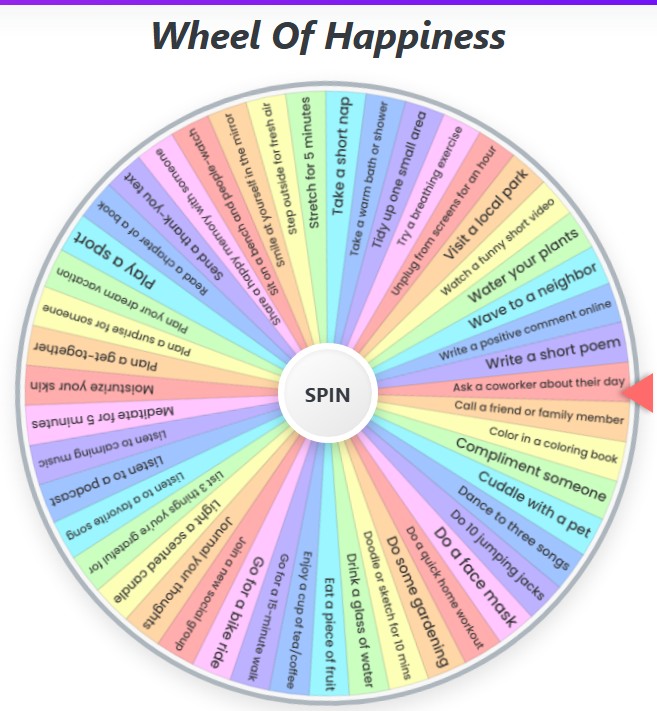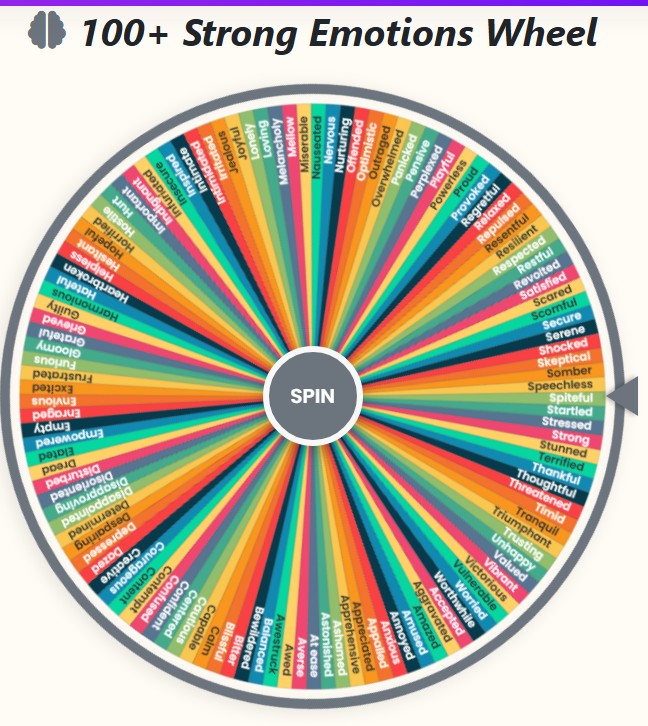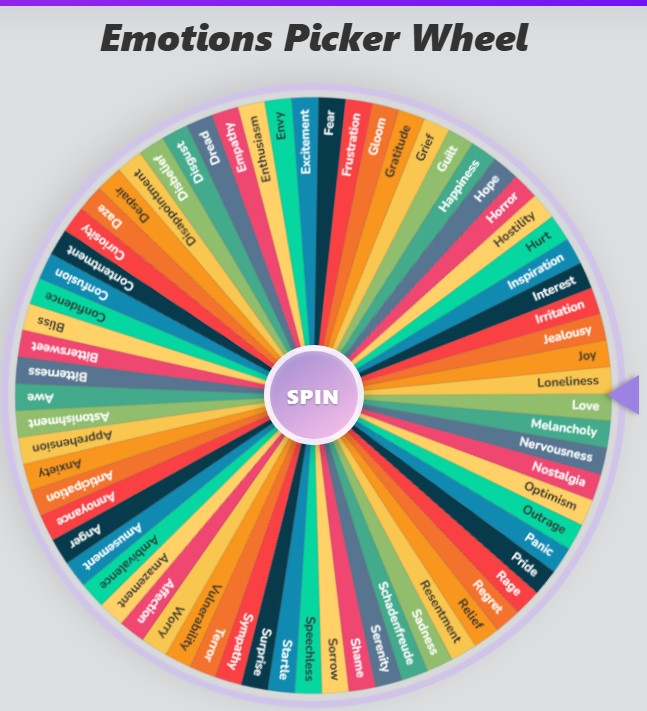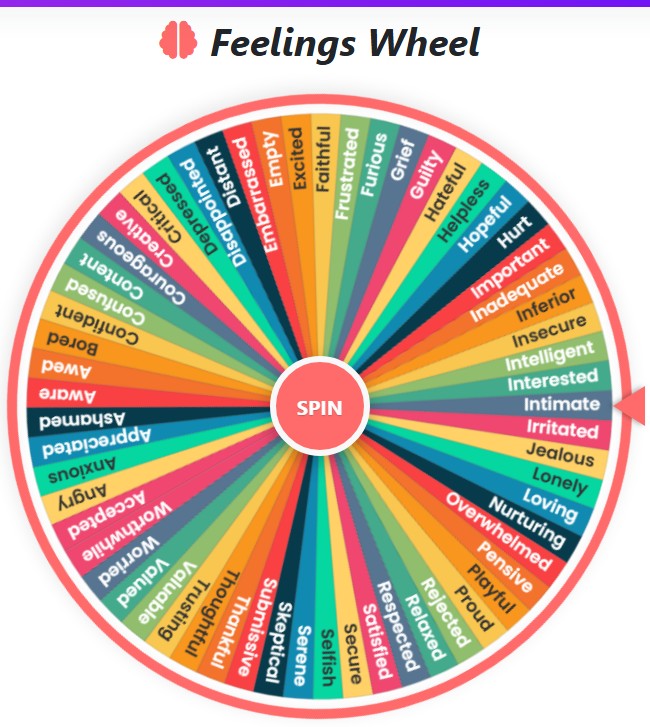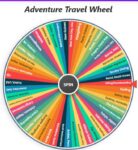Wheel of Awareness
Current Segment: None
Quick Link:
- wheel of life
- 100+ Strong Emotions
- Love Feelings Wheel
- The 5 Love Language Wheel
- anger emotions wheel
- Sad emotion wheel
- Positive Emotions Wheel
- 60 Feelings Picker Wheel
- 70 Emotion Picker Wheel
Master Your Mind: A Deep Dive into Our Interactive Wheel of Awareness Tool
In our hyper-connected, fast-paced world, the mind can often feel like a browser with too many tabs open. We jump from thoughts to worries, from memories to future plans, rarely stopping to just be. But what if you had a simple, visual guide to help you navigate this inner chaos and find your center?
That’s precisely what our interactive Wheel of Awareness tool is designed for. Inspired by the groundbreaking work of Dr. Dan Siegel, this tool is more than just a spinner; it’s your personal trainer for mindfulness. It provides a structured yet flexible path for practicing wheel of awareness meditation, helping you integrate your mind and cultivate a deep sense of presence and well-being. Let’s get started.
Your Focus Points on the Wheel
Before we dive deep, here’s a quick look at the core segments and the specific focus points you’ll find on the wheel. This is the “rim” of your awareness.
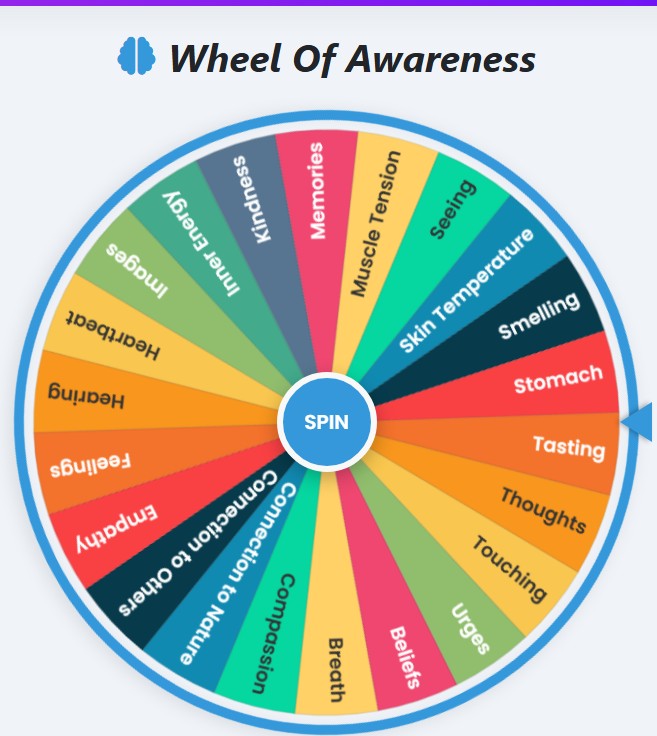
- The Five Senses
- Seeing
- Hearing
- Smelling
- Tasting
- Touching
- The Body
- Breath
- Heartbeat
- Stomach
- Muscle Tension
- Skin Temperature
- Inner Energy
- Mental Activities
- Thoughts
- Feelings
- Memories
- Images
- Beliefs
- Urges
- Connection
- Kindness
- Compassion
- Empathy
- Connection to Others
- Connection to Nature
What Is the Wheel of Awareness?
Great question! The concept, developed by Dr. Dan Siegel, wheel of awareness pioneer and clinical professor of psychiatry, is a powerful metaphor for how the mind works.
Imagine a bicycle wheel. 🚲
- The Hub: At the very center is the hub. This represents your core awareness, the part of you that can observe without judgment. It’s the knowing, the experiencing self.
- The Rim: The outer rim of the wheel is everything you can be aware of. This includes your sensory experiences, bodily sensations, thoughts, feelings, and your connection to the world.
- The Spokes: The spokes connect the hub to the rim. Each spoke represents a focused beam of attention. When you direct your attention from the hub to a point on the rim, you are consciously choosing what to be aware of.
The practice of the wheel of awareness is about strengthening that hub. It’s about learning to direct the spokes of your attention intentionally, rather than letting your focus be pulled all over the rim haphazardly. Our tool digitizes this process, making it an accessible and engaging exercise for everyone.
Navigating Your Awareness Journey
Our digital tool is designed to be intuitive and user-friendly. Think of it as your personal meditation guide, ready whenever you need a moment of clarity. Let’s break down how to use it.
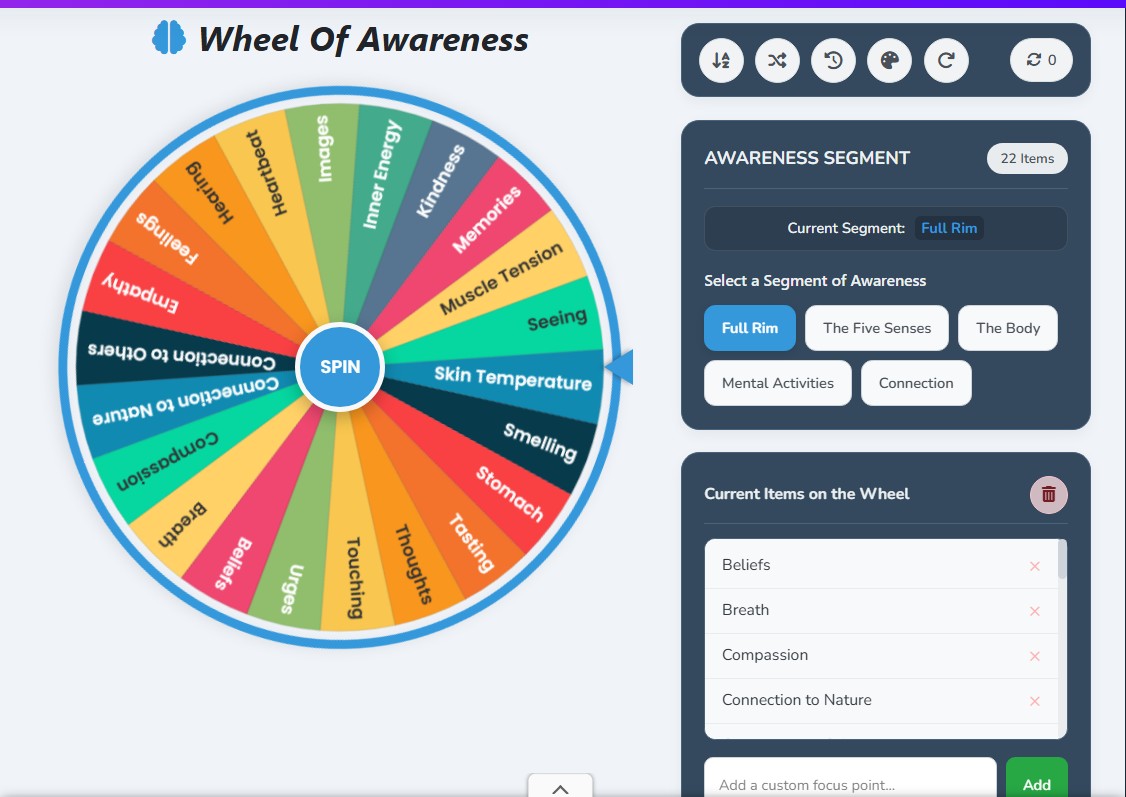
The Spinning Wheel and Pointer
The first thing you’ll notice is the vibrant, colorful wheel. This is the visual representation of the “rim” from Dr. Siegel’s model. Each colored slice contains a specific “focus point”—an item from the categories we listed above.
The pointer on the side is your “spoke” of attention. When the wheel stops, the pointer indicates which focus point you’ll bring your awareness to for your meditation practice. It’s a simple, random selection that removes the pressure of “choosing” what to focus on, allowing you to simply accept and observe.
The Spin Button: Your Starting Point
The big “SPIN” button in the center is the heart of the tool. Pressing it sets the wheel in motion, symbolizing the beginning of your wheel of awareness meditation session. A gentle, pleasant sound accompanies the spin, helping you transition into a mindful state. When the wheel comes to a stop, the real practice begins.
The Hub of Awareness: Your Control Panel
This is your command center for customizing the experience and tracking your journey.
Sort and Shuffle: Want to see the items in alphabetical order? Hit the Sort button. Feeling spontaneous? The Shuffle button will mix up the items on the wheel, giving you a completely new sequence. This is great for keeping the practice fresh and preventing it from becoming robotic.
History: Every time you spin, the result is saved. The History button opens a log of your recent focus points. This is more than just a list; it’s a map of your awareness journey. You might notice patterns, like certain feelings or sensations coming up more often, offering valuable insights into your inner world.
Color Settings: We experience the world in color, so why should your mindfulness tool be drab? The Color Settings (Palette) button lets you customize the wheel’s color scheme. Whether you prefer vibrant, pastel, or earthy tones, you can select a palette that feels calming and inviting to you.
Reset: Feeling like a fresh start? The Reset button restores the tool to its original state. It resets the spin count, clears the history, and reloads the default “Full Rim” category, giving you a clean slate.
Spin Counter: This little number keeps track of how many times you’ve spun the wheel. It’s a simple motivator, showing your commitment to the practice over time. Watching that number grow can be a powerful reinforcement of your dedication to your mental well-being.
Exploring the Segments of Your Mind
The true power of the wheel of awareness lies in its four distinct segments. Our tool allows you to focus on each one individually or explore them all together in the “Full Rim” mode.
The Five Senses 👁️👂👃👅✋
This is the first segment, and it’s the most tangible. It’s about grounding yourself in the present moment by paying close attention to what your senses are telling you. When the wheel lands on an item here, your task is simple:
- Seeing: Don’t just look; see. Notice the colors, shapes, and textures around you. Observe the play of light and shadow.
- Hearing: Tune into the soundscape. Listen to the obvious sounds and the subtle ones—the hum of a fan, distant traffic, your own breathing.
- Smelling: Inhale deeply. What scents can you detect? The coffee on your desk? The fresh air from an open window?
- Tasting: If you’re eating or drinking, savor every bite or sip. If not, just notice the taste inside your mouth.
- Touching: Feel the sensation of your clothes against your skin, your feet on the floor, or the texture of the chair you’re sitting on.
The Body’s Inner World ❤️🌬️
The second segment invites you to turn your awareness inward, to the internal landscape of your body. This is a practice known as interoception. It’s about listening to the quiet, constant signals your body sends.
- Breath: Follow the full cycle of your breath—the inhale, the pause, the exhale. No need to change it, just observe it.
- Heartbeat: Can you feel your pulse? Perhaps in your chest, your neck, or your wrists. Tune into this steady rhythm of life.
- Stomach: Bring your awareness to your belly. Is it settled, gurgling, tight, or relaxed?
- Muscle Tension: Scan your body for areas of tension. Common spots are the jaw, shoulders, and neck. Simply notice the tension without needing to release it.
- Skin Temperature: Feel the temperature of your skin. Are your hands warm or cool? Do you feel a breeze?
- Inner Energy: This is more subtle. Try to sense the aliveness or vitality within you. It might feel like a tingling, a warmth, or a general sense of presence.
The Realm of Mental Activities 🧠💭
This third segment is often the busiest part of the rim. It includes our inner world of thoughts, feelings, and memories. The goal here is not to stop them or analyze them, but to observe them as you would observe clouds passing in the sky.
- Thoughts: Notice the thoughts that arise. Are they about the past, present, or future? Are they words, sentences, or questions? Just watch them come and go.
- Feelings: What emotions are present? Joy, sadness, frustration, calm? Name the feeling and notice where you feel it in your body.
- Memories: A memory might surface. Observe it like a movie playing on a screen, without getting lost in the storyline.
- Images: Your mind might conjure images or daydreams. Notice these mental pictures with gentle curiosity.
- Beliefs: A core belief about yourself or the world might pop up. Simply acknowledge its presence.
- Urges: An urge to move, check your phone, or do something else may arise. Notice the physical sensation of the urge without acting on it.
The Sense of Connection 🤗🌳
The fourth and final segment expands your awareness beyond your own skin. It’s about cultivating a sense of connection and relationship with the world around you. This part of the Dan Siegel wheel of awareness practice promotes empathy, kindness, and a feeling of belonging.
- Kindness: Bring to mind someone you care about and send them kind, loving thoughts. Then, extend that kindness to yourself.
- Compassion: Acknowledge any suffering you or others may be experiencing and meet it with a sense of caring and a desire to help.
- Empathy: Try to sense what it might feel like to be another person. Imagine their perspective and their feelings.
- Connection to Others: Feel your connection to the people in your life—family, friends, colleagues, and even strangers. Recognize our shared humanity.
- Connection to Nature: Sense your connection to the natural world—the air you breathe, the ground that supports you, and all living things.
Your Journey Starts Now
The Wheel of Awareness is more than a tool; it’s an invitation. It’s an invitation to slow down, to turn inward, and to befriend your own mind. Regular practice can lead to profound benefits, including reduced stress, better emotional regulation, improved focus, and a greater sense of peace and integration.
Don’t wait for the “perfect” time to start. Take five minutes right now. Find a quiet spot, take a deep breath, and give the wheel a spin. Let it guide your attention and open you up to the vast, rich world that exists both inside and outside of you. Your journey to a more aware, balanced, and integrated self begins with a single spin. ✨
